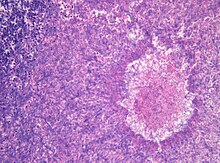Aspergilloma
| Aspergilloma | |
|---|---|
| Other names | Mycetoma, fungus ball, moldy lungs |
Infectious disease | |
| Diagnostic method | Chest x-ray show tumour like opacity. Serology can be helpful. Fungal hyphae seen on KoH mount and sputum culture grows fungus |
An aspergilloma is a clump of
Signs and symptoms
People with aspergillomata typically remain
Aspergillomata can also form in other organs. They can form abscesses in solid organs such as the brain or kidney, usually in people who are immunocompromised. They can also develop within body cavities such as the sphenoid or paranasal sinuses,[2] the ear canal, and rarely on surfaces such as heart valves.[citation needed]
Cause

The most common organ affected by aspergilloma is the lung. Aspergilloma mainly affects people with underlying
Diagnosis
Diagnosis of aspergilloma is by serum IgE levels which are usually raised in this condition.
Treatment
Most cases of aspergilloma do not require treatment.[citation needed] Treatment of diseases which increase the risk of aspergilloma, such as tuberculosis, may help to prevent their formation. In cases complicated by severe hemoptysis or other associated conditions such as pleural empyema or pneumothorax, surgery may be required to remove the aspergilloma and the surrounding lung tissue by doing a lobectomy or other types of resection and thus stop the bleeding. There has been interest in treatment with antifungal medications such as itraconazole and voriconazole with some reports showing aspergilloma eradication.[4]
Although most fungi—and especially Aspergillus—fail to grow in healthy human tissue, significant growth may occur in people whose
References
- ^ "Aspergilloma". Medical Dictionary. TheFreeDictionary.
- ^ "Life". Archived from the original on 2017-06-22. Retrieved 2014-10-21.
- PMID 12065367. Archived from the originalon 2013-04-14.
- ISSN 0301-486X.
- PMID 6932257.
